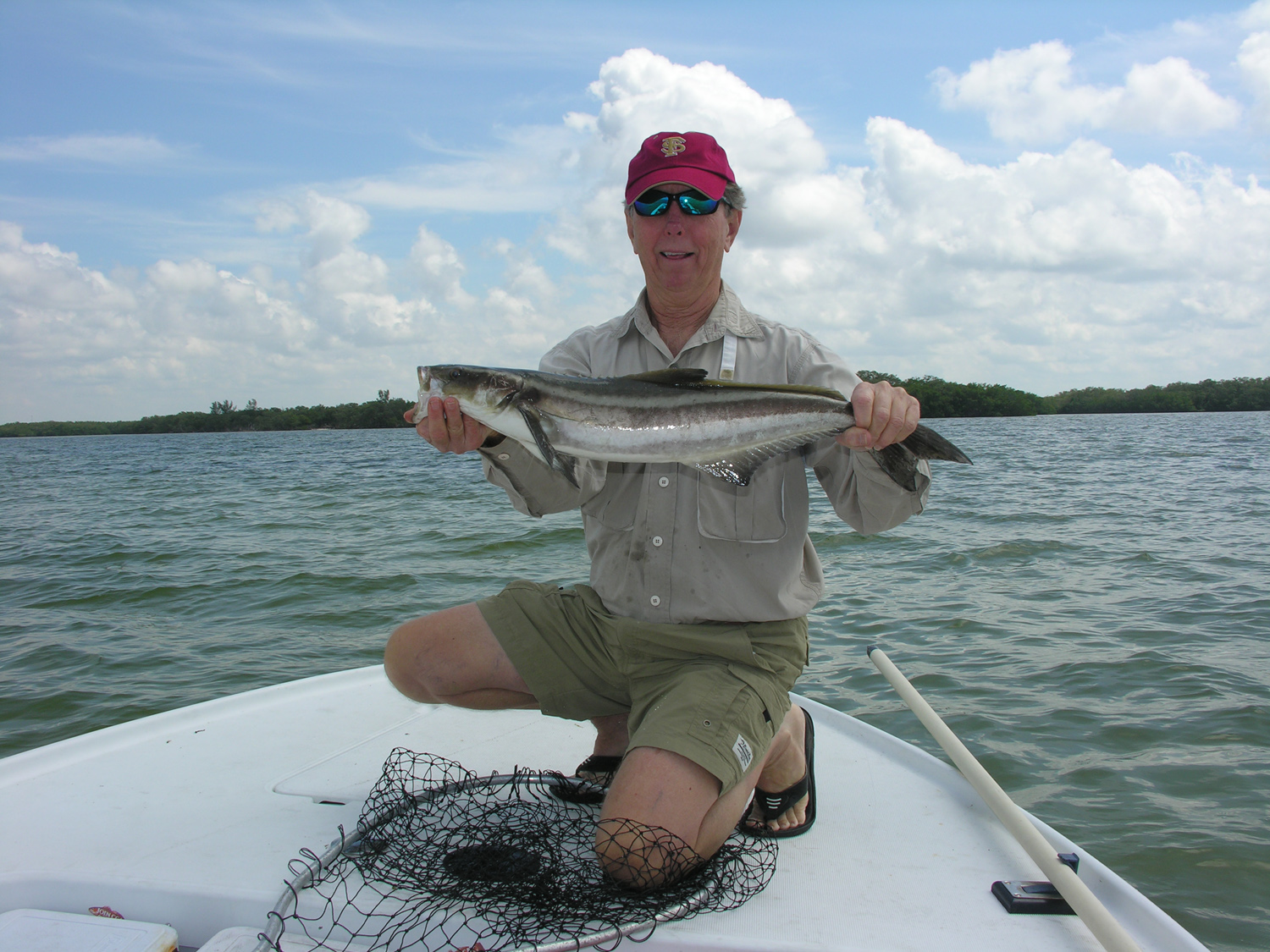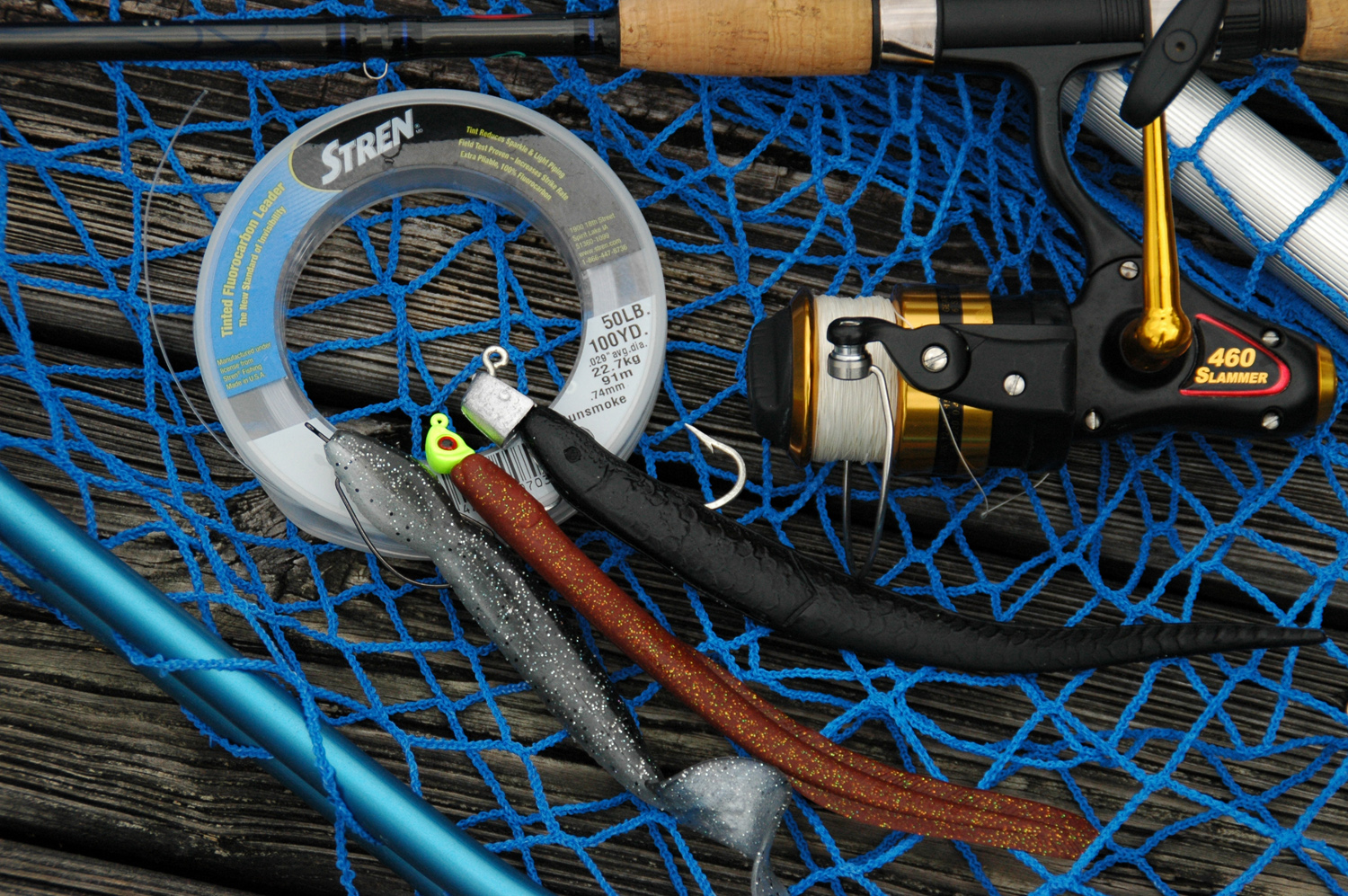September 19, 2011
By Fred Everson
Be ready this winter for surprise encounters on the flats.
 Sturdy net comes in handy when you hook one of those powerful cobia.
Sturdy net comes in handy when you hook one of those powerful cobia.
It was a rare calm day in December and we had just finished catching a mess of sheepshead on the artificial reef off Bahia Beach. On the way back to the dock I suggested we idle across some south Tampa Bay flats looking for cobia.
“This time of year?” my friend Capt. Tom Rinehart asked.
“Yup. The water temperature is up around 69 degrees and there are always a few fish that spend the winter in the bay.”
I rigged a 1/2-ounce RipTide jighead with a plastic mullet and got on the bow, while Tom drove the boat from the top of his tower. The sun was high in a clear blue sky and the winds were light—perfect conditions for stalking big ling. We cruised onto the flat and headed inshore until we got into about three feet of water. This put us right on an edge where grass meets bare sand.
“There's an eagle ray a hundred yards out, right down the centerline of the boat,” Tom said.
I could barely make out the shadow from deck level but I could see the occasional flash of a wing tip. Tom bumped the throttle up a bit and we closed on the ray. When we got within 40 yards I could see there was indeed a fish on his back.
“He's got company!” Tom said.
“All right, get us 20 yards abeam of the ray; we don't want to spook it.”
 This fish was hooked near a marker buoy on Tampa Bay.
This fish was hooked near a marker buoy on Tampa Bay.
Careful to maintain some distance between the boat and the ray, Tom eased us off to his right. As we came even with the ray and the fish, I cast the jig 10 feet in front of them and began a quick retrieve as soon as the lure hit the water. The plastic mullet passed in front of the pair at three feet, and the cobia instantly came off the ray to chase the lure. I swept the rodtip to speed up the bait, and the fish just couldn't let it get away. It struck with such force that no hookset was required, even with this hard-mouthed crab eater.
The fish peeled off 50 yards of line in a heartbeat and there was nothing to do but keep the rod bent and watch. Two or three more runs like that and the fish was finally done. As it came alongside the boat, I guessed it was just shy of the minimum size, 33 inches to the fork of the tail. Tom grabbed the 60-pound leader with one hand and got hold of the jig hook with his dehooker, and the fish was free to go about his business.
“Let's look for another one,” I said to Tom.
We hadn't gone a hundred yards when Tom spotted another fish from the tower. It was high in the water, just below the surface with the sun shining off his back.
“That's another cobia!” I said.
There are a lots of bonnethead sharks on this flat in the winter months, and they are similar in size and appearance to cobia. But the sharks prefer to hug the bottom, and they swim with a snakelike slither. Cobia tend to stay higher in the water column and swim in a straight line. This fish was almost poking its dorsal fin through the surface, and wasn't meandering.
Tom approached the fish carefully, veering away from it when the cobia changed course and started coming toward the boat. Sometimes they get curious and will swim right up to the boat, and follow in the wake. While this might be exciting, it's hard to get a hook into a fish so close to the boat. Captain Chet Jennings told me he actually force fed a cobia a fly by thrusting the rodtip in the fish's mouth as it trailed in his wake. That's one way to do it, but I like them at medium casting distance where I can place the lure so the fish can see it, taking care not to put it too close. The first shot you get with cobia is usually going to be your best chance, so I try not to drop the jig where it could scare the fish. Sometimes they will hit a second or third cast, but the highest percentage for hookups is with the initial offering.
This is probably why the jig is the hands-down favorite of cobia fishermen. It casts well, and the single hook sets a lot surer than trebles. It does not seem to matter what's on the jig if the fish are in the mood, but the plastic eel is always a cobia killer. Even though I have never seen an eel on Tampa Bay, I keep a bag of 10-inch black eels in my box during peak season. Here, it runs from late February through mid June. When the water heats up on the flats, the fish tend to gather on offshore structure, such as range markers and channel buoys.
I made an easy cast about 10 feet in front of the fish, and as soon as he saw the lure he charged—a second easy hookup. This fish lasted about 10 minutes, and was the same size as the first, so back it went.
It's difficult to plan a winter cobia trip around tides and weather, but you should prepare for chance encounters. I carry a medium-heavy, fast-action spinning rod loaded with 30-pound microfilament, rigged with 3 feet of 50- or 60-pound leader and a jighead tipped with a plastic eel. If the sun comes out and the wind lies down, I'm ready. Water clarity is seldom a problem when you are apt to find cobia on the flats, as cold weather inhibits algae growth.
When hunting cobia from my poling skiff, I have a friend drive the boat at idle speed as I stand on the poling platform. The advantage of height is substantial. On a flat calm day, I can often spot individual fish over a hundred yards away.

Plastic eels and a heavier spinning rod are worth packing on the skiff.
Sometimes cobia will simply not take a piece of plastic. If I have a couple of good casts at fish and they follow the lure but don't take it, I rig a large live shrimp on a ½-ounce jighead. I like to break the fan off the tail and bring the hook up through the belly. This is a natural presentation of the shrimp, and will not twist the line. Sometimes it takes scent to trigger a strike. Those who live-bait cobia generally prefer large pinfish. Threadfin herring and scaled sardines also do the trick. I have even caught them on a strip of squid.
Getting the bait where they can see it, and then keeping it moving is more important than what's on the hook.
